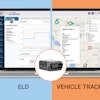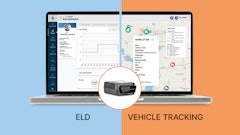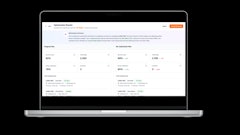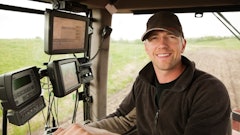While companies find it fairly easy to control data flow in their warehouses and on their docks, they often lose visibility and control once the loads are dispatched and trucks are on the road. Many companies sought out onboard computer and communications systems to help them gain that visibility, only to find out later on that coverage areas were limited, keeping their drivers out of touch anyway.
Fleet operators in the past had only two choices—satellite or cellular. Satellite offered greater coverage but was more expensive on a per-character basis. Cellular was significantly less expensive, but coverage was spotty. In response, a number of onboard communications and computer systems providers within the last year or two started exploring new technologies to expand those coverage areas, offering multi-mode systems that can use any combination of radio, satellite, digital cellular, analog cellular and Internet systems in one solution.
GeoLogic Solutions, Herndon, VA, formerly the Transportation Division of Aether Systems, was the first to offer mobile communications and onboard systems that use both terrestrial and satellite-based networks. It's MobileMax multi-mode communications system automatically selects the faster, lower cost terrestrial network for data transmission first, and switches seamlessly to satellite when coverage is needed in remote areas. Not only does it provide a means for relaying voice and text messages and GPS data, the system automatically records state line crossings, monitors driver and vehicle performance, communicates engine fault codes and alerts companies when a driver arrives or departs from pre-set geofenced locations.
Scarborough, ME-based truckload carrier R.C. Moore was an early adopter of previous mobile communications systems and recently upgraded its fleet of 135 trucks with the new MobileMax multi-mode system from GeoLogic. Other companies that recently upgraded to the MobileMax system include Sharkey Transportation, Quincy, IL; South''east Freight Lines, Jacksonville, FL; DMT Services, Siloam Springs, AR; Con'way Courier Service, based in Ala'bama; and TransAm Trucking, Olathe, KS.
"We clearly had a need to be able to meet shipper and receiver requests for onboard communications and tracking capabilities," says Jason Johnson, safety director for Conway. "The cell phones we had been using to communicate with drivers did not offer the abilities we needed to effectively service our customers."
Since MobileMax first hit the scene, a number of other onboard systems pro'viders have started offering multi-mode solutions as well. Among them are XATA Corp., Minneapolis; Cadec Corp., Londonderry, NH; Tripmaster Corp., Arlington, TX; Terion, Plano, TX; AirIQ, Toronto; @Road, Fremont, CA; and PeopleNet, Minneapolis, to name a few.
"The addition of satellite communication, used in conjunction with terrestrial communication, is a natural progression toward [Cadec's] goal of having the most complete and cost-effective communication offering in the trucking industry," says Les Dole, president and CEO of Cadec, which offers a satellite component to its Mobius TTS onboard system.
The addition of satellite gives customers steady communication with drivers and onboard systems at all times and where there is no other communications availability for extended periods of time, Dole says.
"When drivers are in digital coverage areas, they have a very fast connection for the information they're sending from the truck," says Tom Flies, vice president of business development at XATA, which offers digital cellular, satellite and Wi-Fi capabilities as part of its XATANET on'board package. "The satellite gives them universal coverage across the nation."
That quickly became a requirement for Valley Proteins, Winchester, VA, an independent recycler of food by-products. The company's 450-vehicle fleet was recently outfitted with XATANET. Company executives often need to measure how drivers run their routes and provide guidance on areas of improvement after routes have been completed, but, found it difficult to do so because many of the trucks operate in areas where cellular coverage is unavailable.
"We expect XATANet's ease of use and rapid implementation to generate immediate results across our entire fleet," says Kirby Brown, chief financial officer of Valley Proteins. "Having XATANet onboard our trucks will be like having a supervisor riding with our drivers at all times, which will lead to increased driver productivity, enhanced safety and an immediate impact on our bottom line."
"The result is a best-of-breed platform capable of delivering high-value applications that are attractive and proven to reduce operating costs for all fleet types," says John Sarto, president and CEO of PeopleNet, which began offering multi-mode transmission as part of its g3 solution in 2004.
While most systems switch between digital cellular and satellite data transmission methods, PeopleNet's g3 switches between digital and analog cellular transmissions. Analog digital communications, though more expensive than digital, is still less expensive than satellite, and isn't hindered by cloud cover, urban canyons or a lack of service that is common with satellite, says Brian McLaughlin, vice presi'dent of product marketing for PeopleNet.
In addition, satellite's bandwidth is limited to about 18,000 characters at a time, and fees average about $50 a month, while analog offers a bandwidth that is 500 times greater. "With analog, you can send several megabytes [of information] for about the same cost or less," he says. "And, traditional satellite networks are very slow in passing a lot of data through them. There are some latency issues with all systems, but it's a lot less with analog because of the wider bandwidth."
Several foodservice fleets, including Affiliated Foods, Quickway and Domino's Pizza, are among the list of companies that implemented PeopleNet's g3 system last year.
Tripmaster customers using the company's DT-240/GPS or TKO Onboard Computer systems can choose between the LandLink terrestrial wireless network for use in metropolitan or regional operating areas, or the Trip'master multi-mode platform for coverage if operations go beyond. Within each platform, messages are sent and received via Tripmaster's Driver Data Terminal I or II, or handheld computers. Custom'ers can log onto a secure Web site to see where drivers are located or communicate with them using free-form or pre-programmed messages. Store-and-forward technology and additional levels of message acknowledgements are also available.
Driving Down Costs
While all these solutions, regardless of their mode of transmission, often include GPS and communications packages, they also are used to send data—including truck and driver performance, accident reconstruction, reefer temperature monitoring, driver logs, load status, routing and scanned images of signatures, barcodes and full documents—back and forth between the truck and the office.
Because they transmit over the faster, lower-cost digital cellular networks first and switch to a satellite or analog cellular network only when traditional digital coverage is not available, these systems reportedly provide greater reliability and reduce monthly communications fees by as much as 40 percent over standard satellite-only systems.
"Cost is a huge factor," says McLaughlin. "Satellite alone is very costly and you do not get capacity. Digital alone offers lower costs and more bandwidth, but not much coverage."
And because of increasing competition, prices for service are coming down, and costs for the truck hardware and installation are following suit. Up-front costs for most on-board computer systems and the other necessary hardware range from $1,000 to $1,200; monthly fees for most services range from $35 to $60 per truck, according to McLaughlin. "Costs have really come down in the last few years because of scale in the industry."
"You can get an ROI in as little as six months when you factor in driver productivity, fuel economy and better customer service," says XATA's Flies.
An added benefit of these systems is a more reliable platform for service pro'viders to perform over-the-air programming (OTAP), allowing them to remotely update the systems with new capabilities and product enhancements wirelessly while trucks are on the road. OTAP "allows us to update the programs quickly," says Flies.
Systems like XATANET also feature a Wi-Fi component, which allows an onboard system to communicate with wire'less access points in the yard. "The driver can also upload and download information through it right in the yard. He doesn't have to go into a break office or to the dispatcher to get his next assignment," Flies says.
Wi-Fi capability is also a feature of Cadec's Mobius TTS system. Using wireless local area network (WLAN) interfaces, the onboard hub inside the cab connects to a company's computer systems over a broadband, short-range link for downloading and uploading information.
Tripmaster also offers this Wi-Fi capability. Tripmaster Wireless transfers data from the OBC to and from Tripmaster Office software. Vehicles can be positioned anywhere in the yard, eliminating the need for drivers to go through close-proximity, pass-through points and the wasted time spent at data extraction stations.
Though these types of systems are just starting to gain in popularity now, Richard Kochersperger, director of the Food Marketing Group in Wallingford, PA, ac'knowledges that they have not reached the level of usage that they should. "All of the over-the-road and inbound guys have it. Would I have it? Absolutely, but the industry is not so fast to adopt it," he says. "You want to do everything you can to protect yourself, your drivers and your business.















